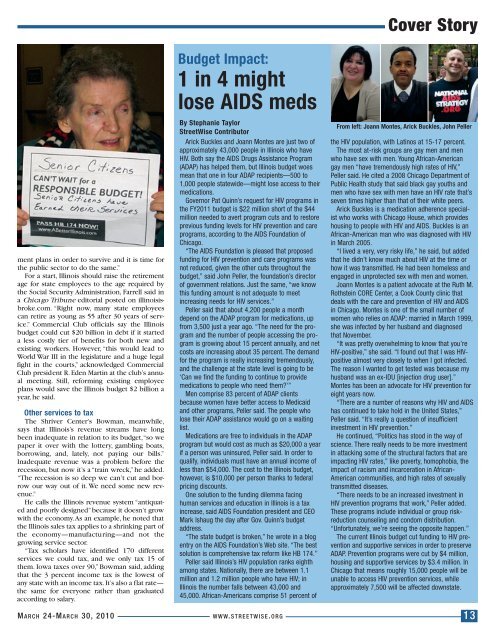Green or White... Asparagus is out of sight! - Ginny Erwin
Green or White... Asparagus is out of sight! - Ginny Erwin
Green or White... Asparagus is out of sight! - Ginny Erwin
Create successful ePaper yourself
Turn your PDF publications into a flip-book with our unique Google optimized e-Paper software.
Cover St<strong>or</strong>y<br />
ment plans in <strong>or</strong>der to survive and it <strong>is</strong> time f<strong>or</strong><br />
the public sect<strong>or</strong> to do the same.”<br />
F<strong>or</strong> a start, Illino<strong>is</strong> should ra<strong>is</strong>e the retirement<br />
age f<strong>or</strong> state employees to the age required by<br />
the Social Security Admin<strong>is</strong>tration, Farrell said in<br />
a Chicago Tribune edit<strong>or</strong>ial posted on illino<strong>is</strong><strong>is</strong>broke.com.<br />
“Right now, many state employees<br />
can retire as young as 55 after 30 years <strong>of</strong> service.”<br />
Commercial Club <strong>of</strong>ficials say the Illino<strong>is</strong><br />
budget could cut $20 billion in debt if it started<br />
a less costly tier <strong>of</strong> benefits f<strong>or</strong> both new and<br />
ex<strong>is</strong>ting w<strong>or</strong>kers. However, “th<strong>is</strong> would lead to<br />
W<strong>or</strong>ld War III in the leg<strong>is</strong>lature and a huge legal<br />
fight in the courts,” acknowledged Commercial<br />
Club president R. Eden Martin at the club’s annual<br />
meeting. Still, ref<strong>or</strong>ming ex<strong>is</strong>ting employee<br />
plans would save the Illino<strong>is</strong> budget $2 billion a<br />
year, he said.<br />
Other services to tax<br />
The Shriver Center’s Bowman, meanwhile,<br />
says that Illino<strong>is</strong>’s revenue streams have long<br />
been inadequate in relation to its budget, “so we<br />
paper it over with the lottery, gambling boats,<br />
b<strong>or</strong>rowing, and, lately, not paying our bills.”<br />
Inadequate revenue was a problem bef<strong>or</strong>e the<br />
recession, but now it’s a “train wreck,” he added.<br />
“The recession <strong>is</strong> so deep we can’t cut and b<strong>or</strong>row<br />
our way <strong>out</strong> <strong>of</strong> it. We need some new revenue.”<br />
He calls the Illino<strong>is</strong> revenue system “antiquated<br />
and po<strong>or</strong>ly designed” because it doesn’t grow<br />
with the economy. As an example, he noted that<br />
the Illino<strong>is</strong> sales tax applies to a shrinking part <strong>of</strong><br />
the economy—manufacturing—and not the<br />
growing service sect<strong>or</strong>.<br />
“Tax scholars have identified 170 different<br />
services we could tax, and we only tax 15 <strong>of</strong><br />
them. Iowa taxes over 90,” Bowman said, adding<br />
that the 3 percent income tax <strong>is</strong> the lowest <strong>of</strong><br />
any state with an income tax. It’s also a flat rate—<br />
the same f<strong>or</strong> everyone rather than graduated<br />
acc<strong>or</strong>ding to salary.<br />
M A R C H 24-MARCH 30, 2010<br />
Budget Impact:<br />
1 in 4 might<br />
lose AIDS meds<br />
By Stephanie Tayl<strong>or</strong><br />
StreetW<strong>is</strong>e Contribut<strong>or</strong><br />
Arick Buckles and Joann Montes are just two <strong>of</strong><br />
approximately 43,000 people in Illino<strong>is</strong> who have<br />
HIV. Both say the AIDS Drugs Ass<strong>is</strong>tance Program<br />
(ADAP) has helped them, but Illino<strong>is</strong> budget woes<br />
mean that one in four ADAP recipients—500 to<br />
1,000 people statewide—might lose access to their<br />
medications.<br />
Govern<strong>or</strong> Pat Quinn’s request f<strong>or</strong> HIV programs in<br />
the FY2011 budget <strong>is</strong> $22 million sh<strong>or</strong>t <strong>of</strong> the $44<br />
million needed to avert program cuts and to rest<strong>or</strong>e<br />
previous funding levels f<strong>or</strong> HIV prevention and care<br />
programs, acc<strong>or</strong>ding to the AIDS Foundation <strong>of</strong><br />
Chicago.<br />
“The AIDS Foundation <strong>is</strong> pleased that proposed<br />
funding f<strong>or</strong> HIV prevention and care programs was<br />
not reduced, given the other cuts through<strong>out</strong> the<br />
budget,” said John Peller, the foundation’s direct<strong>or</strong><br />
<strong>of</strong> government relations. Just the same, “we know<br />
th<strong>is</strong> funding amount <strong>is</strong> not adequate to meet<br />
increasing needs f<strong>or</strong> HIV services.”<br />
Peller said that ab<strong>out</strong> 4,200 people a month<br />
depend on the ADAP program f<strong>or</strong> medications, up<br />
from 3,500 just a year ago. “The need f<strong>or</strong> the program<br />
and the number <strong>of</strong> people accessing the program<br />
<strong>is</strong> growing ab<strong>out</strong> 15 percent annually, and net<br />
costs are increasing ab<strong>out</strong> 35 percent. The demand<br />
f<strong>or</strong> the program <strong>is</strong> really increasing tremendously,<br />
and the challenge at the state level <strong>is</strong> going to be<br />
‘Can we find the funding to continue to provide<br />
medications to people who need them?’”<br />
Men compr<strong>is</strong>e 83 percent <strong>of</strong> ADAP clients<br />
because women have better access to Medicaid<br />
and other programs, Peller said. The people who<br />
lose their ADAP ass<strong>is</strong>tance would go on a waiting<br />
l<strong>is</strong>t.<br />
Medications are free to individuals in the ADAP<br />
program but would cost as much as $20,000 a year<br />
if a person was uninsured, Peller said. In <strong>or</strong>der to<br />
qualify, individuals must have an annual income <strong>of</strong><br />
less than $54,000. The cost to the Illino<strong>is</strong> budget,<br />
however, <strong>is</strong> $10,000 per person thanks to federal<br />
pricing d<strong>is</strong>counts.<br />
One solution to the funding dilemma facing<br />
human services and education in Illino<strong>is</strong> <strong>is</strong> a tax<br />
increase, said AIDS Foundation president and CEO<br />
Mark Ishaug the day after Gov. Quinn’s budget<br />
address.<br />
“The state budget <strong>is</strong> broken,” he wrote in a blog<br />
entry on the AIDS Foundation’s Web site. “The best<br />
solution <strong>is</strong> comprehensive tax ref<strong>or</strong>m like HB 174.”<br />
Peller said Illino<strong>is</strong>’s HIV population ranks eighth<br />
among states. Nationally, there are between 1.1<br />
million and 1.2 million people who have HIV; in<br />
Illino<strong>is</strong> the number falls between 43,000 and<br />
45,000. African-Americans compr<strong>is</strong>e 51 percent <strong>of</strong><br />
W W W. S T R E E T W I S E.ORG<br />
From left: Joann Montes, Arick Buckles, John Peller<br />
the HIV population, with Latinos at 15-17 percent.<br />
The most at-r<strong>is</strong>k groups are gay men and men<br />
who have sex with men. Young African-American<br />
gay men “have tremendously high rates <strong>of</strong> HIV,”<br />
Peller said. He cited a 2008 Chicago Department <strong>of</strong><br />
Public Health study that said black gay y<strong>out</strong>hs and<br />
men who have sex with men have an HIV rate that’s<br />
seven times higher than that <strong>of</strong> their white peers.<br />
Arick Buckles <strong>is</strong> a medication adherence special<strong>is</strong>t<br />
who w<strong>or</strong>ks with Chicago House, which provides<br />
housing to people with HIV and AIDS. Buckles <strong>is</strong> an<br />
African-American man who was diagnosed with HIV<br />
in March 2005.<br />
“I lived a very, very r<strong>is</strong>ky life,” he said, but added<br />
that he didn’t know much ab<strong>out</strong> HIV at the time <strong>or</strong><br />
how it was transmitted. He had been homeless and<br />
engaged in unprotected sex with men and women.<br />
Joann Montes <strong>is</strong> a patient advocate at the Ruth M.<br />
Rothstein CORE Center, a Cook County clinic that<br />
deals with the care and prevention <strong>of</strong> HIV and AIDS<br />
in Chicago. Montes <strong>is</strong> one <strong>of</strong> the small number <strong>of</strong><br />
women who relies on ADAP: married in March 1999,<br />
she was infected by her husband and diagnosed<br />
that November.<br />
“It was pretty overwhelming to know that you’re<br />
HIV-positive,” she said. “I found <strong>out</strong> that I was HIVpositive<br />
almost very closely to when I got infected.<br />
The reason I wanted to get tested was because my<br />
husband was an ex-IDU [injection drug user].”<br />
Montes has been an advocate f<strong>or</strong> HIV prevention f<strong>or</strong><br />
eight years now.<br />
“There are a number <strong>of</strong> reasons why HIV and AIDS<br />
has continued to take hold in the United States,”<br />
Peller said. “It’s really a question <strong>of</strong> insufficient<br />
investment in HIV prevention.”<br />
He continued, “Politics has stood in the way <strong>of</strong><br />
science. There really needs to be m<strong>or</strong>e investment<br />
in attacking some <strong>of</strong> the structural fact<strong>or</strong>s that are<br />
impacting HIV rates,” like poverty, homophobia, the<br />
impact <strong>of</strong> rac<strong>is</strong>m and incarceration in African-<br />
American communities, and high rates <strong>of</strong> sexually<br />
transmitted d<strong>is</strong>eases.<br />
“There needs to be an increased investment in<br />
HIV prevention programs that w<strong>or</strong>k,” Peller added.<br />
These programs include individual <strong>or</strong> group r<strong>is</strong>kreduction<br />
counseling and condom d<strong>is</strong>tribution.<br />
“Unf<strong>or</strong>tunately, we’re seeing the opposite happen.”<br />
The current Illino<strong>is</strong> budget cut funding to HIV prevention<br />
and supp<strong>or</strong>tive services in <strong>or</strong>der to preserve<br />
ADAP. Prevention programs were cut by $4 million,<br />
housing and supp<strong>or</strong>tive services by $3.4 million. In<br />
Chicago that means roughly 15,000 people will be<br />
unable to access HIV prevention services, while<br />
approximately 7,500 will be affected downstate.<br />
13






